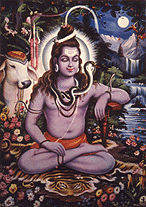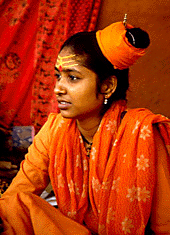
| Text and photographs by Dolf
Hartsuiker, author of the book "Sadhus, Holy Men of
India". |
| Spiritual
adventurers, ascetic warriors, devout mystics, occult rebels or
philosophic monks, the sadhus are revered by Hindus as representatives of the gods, sometimes even worshipped as gods themselves. |
 |
| Shiva is always
naked, which symbolizes his primal condition, his non-attachment to the
world. His body shows feminine characteristics, like soft rounded contours and no beard, which is symbolic of his transcendence of opposites, the primal unity of polarities. | ||
With half-closed eyes he is immersed in meditation, in divine bliss. The Ganges springs from his long hair, his jata, as a fountain, splashing in the Himalayan mountains in the distance. The crescent -- the new moon, 'Shiva's moon' -- on his forehead, the cobra around his neck, the white bull Nandi, the river Ganges, and the full moon form a symbolic cluster which indicates Shiva's function as a fertility deity, a moon god. |
 |
On his forehead are three horizontal lines, painted with ashes, representing the three main gods, the three 'worlds', etc. Around his neck is a garland of 108 beads, the 108 elements of material creation, and in his hand a rosary of 50 beads, the 50 letters of the Sanskrit alphabet. The two large rings through his ears are indicative of his extra-sensory perception. He is seated on a tiger skin, a symbol of power, showing his mastery over the animal world. |
| Holy
Women In contrast with the many young male sadhus, a beautiful young woman is but rarely seen in the brotherhood. About ten percent of sadhus are women, called sadhvis, but most of them are old, having become sadhvi after they were widowed. This reflects the generally subordinate position of women in Indian society -- the popular belief is that women have to be born again as men before they can be spiritually liberated -- and the even more marginal position of widows. Choosing the sadhu life was -- and still is -- about the only respectable way to escape from the 'living death' of widowhood. Nevertheless, since time immemorial there have been
female sadhus. And quite a few have, like their male counterparts, chosen
the sadhu life in their teens, convinced as they were of their spiritual
predestination. |

1975 This graceful lady sadhu, Sobhna Giri, belongs to the Juna Akhara. She entered sadhu life when still a child and thus committed herself to life-long celibacy and other ascetic practices. | |
| Kumbha Mela |
Links |
Bibliography | |
For comments: dolfhart@knoware.nl |
|||